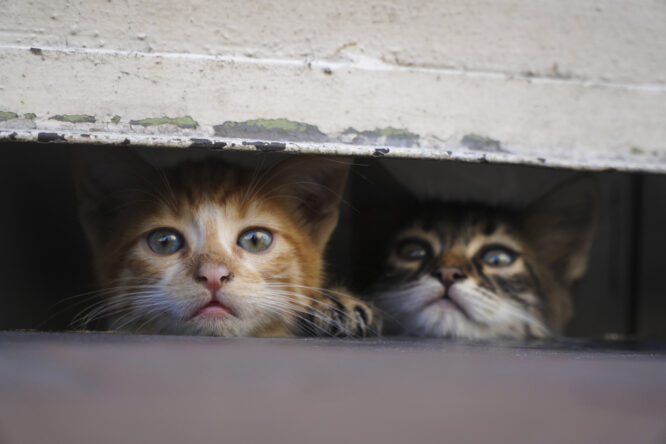Taking in a stray cat can be a deeply rewarding experience, but it also comes with its own set of surprises, responsibilities, and emotional highs and lows.

Whether you’re an experiencing cat owner or a newbie to the world of furry friends, it’s important to be prepared for what may be in store when you welcome a new kitty into your home. Here’s what to expect if you’re opening your door to a feline who’s used to surviving on their own. While every cat is different, certain behavioural patterns are pretty common across the board.
1. They may not trust you right away, and that’s okay.

Stray cats often come from situations where they’ve had to fend for themselves, so don’t expect instant cuddles. They might be skittish, hide for hours, or react defensively at first. Patience is key in building trust, and every small step counts. Instead of forcing interaction, let them get used to your presence. Sit near them quietly, speak gently, and offer treats to build a bond. The trust will come, but on their terms, not yours.
2. A vet visit isn’t optional—it’s the first step.

Even if they seem healthy, you’ll want a full checkup right away. Strays can carry parasites, infections, or injuries that aren’t immediately visible. Some conditions need urgent care, even if the cat acts fine. It’s also crucial for preventing the spread of disease if you have other pets. Vaccinations, flea treatments, and microchipping will help start their new chapter safely and responsibly.
3. You might never know their full backstory.

Stray cats don’t come with medical records or past histories, which can make things feel uncertain at first. You may never know if they were abandoned, lost, or born outside. That mystery can be frustrating, especially when you’re trying to figure out why they react a certain way. However, focusing on the cat in front of you, not the past you can’t access, makes the transition easier for both of you.
4. Their behaviour could change dramatically once they feel safe.

Don’t assume their first few days reflect their real personality. A cat who hides under the bed for a week might later become your shadow. Likewise, a friendly stray might get a little distant once they realise they’re in a new environment. As they settle in, you’ll start to see their true temperament. Let them set the pace. It’s all part of them learning that they’re finally safe.
5. The litter box might be confusing at first.

Outdoor cats don’t always instinctively use litter boxes, especially if they’ve never seen one before. Accidents are common in the early days, and that doesn’t mean they’re difficult—it just means they’re learning. Give them a quiet, easily accessible spot and keep the box clean. Unscented litter works best at first. Most cats catch on quickly once they realise it’s a safe and private place to go.
6. Food security will be a big deal.

Stray cats are used to hunting or scavenging, so even if you’re feeding them regularly, they may still act like food is scarce. They might overeat, guard their bowl, or act panicked when meals are late. As time goes on, routine feeding helps them understand they don’t have to worry anymore. Scheduled meals can be more comforting than free-feeding while they adjust to a new sense of safety.
7. They may not be used to being indoors.

Some strays have never lived inside a home. Things like TVs, mirrors, and ceiling fans can scare them, and they might be drawn to escape through windows or doors. Try to create a calm, enclosed space during their first few days. Let them explore slowly and always check for escape risks, especially if they get spooked easily.
8. Grooming might take a back seat at first.

Cats are usually fastidious groomers, but stress, malnutrition, or injury can interfere. If they look matted or messy, don’t assume they’re lazy or unclean—it could be a trauma response or physical limitation. A vet can rule out any medical causes, and over time, good nutrition and a sense of safety will help their self-care instincts return. For long-haired cats, you may need to help them along gently with brushing.
9. They might bond with you more deeply than expected.

Once trust is built, a former stray can form a remarkably strong attachment. You were their turning point, the person who gave them a chance when they had nothing. That kind of connection can run deep. You may notice they follow you from room to room, sleep nearby, or seek constant reassurance. While it’s beautiful, it can also mean they struggle with separation, so easing into routines slowly helps them feel secure.
10. Other pets may not adjust as quickly as you.

If you have other animals, they might be confused or even territorial at first. A slow introduction is crucial—never toss them in together right away and expect it to go smoothly. Use scent swapping (like blankets or toys) and short, supervised visits to build familiarity. Be patient. The goal is peaceful cohabitation, not instant friendship.
11. You’ll likely deal with some emotional ups and downs.

Taking in a stray isn’t always an easy, magical transition. You might feel overwhelmed, frustrated, or unsure at times. That doesn’t mean you’re doing it wrong—it means you’re adjusting, too. Keep asking questions, stay flexible, and give yourself credit. You’re learning how to care for a cat with a complex past, and that comes with real emotional weight.
12. You’re giving them a second chance, and that’s everything.

At the end of the day, adopting a stray cat is about rewriting their story. You’re offering comfort where there was fear, warmth where there was cold, and connection where there was survival mode. It’s not always tidy or predictable, but it’s incredibly meaningful. And once that bond forms, it’s one of the most rewarding relationships you’ll ever have.




